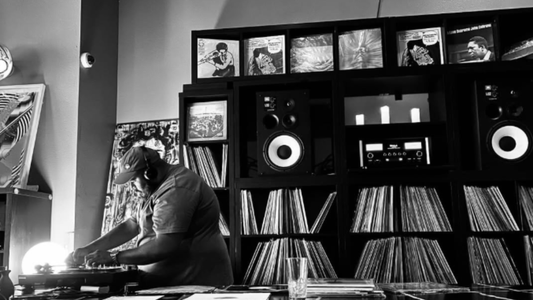
Kissa — The Japanese Origins of Listening Culture
Kissa
Kissa. The word is simple, almost throwaway. In Japanese it means café, a place to drink tea or coffee, to pause for a moment between one part of the day and the next. But when attached to music it becomes something more precise, more resonant: jazz kissa. A listening café. A place where the drink is incidental and the music is everything. A space where silence is respected, where the system is tuned with monastic care, where the act of listening is given dignity. Kissa is the soil from which the listening bar movement grew, and to understand it is to understand why we listen differently when we step into these rooms.
The origins lie in post-war Japan, when imported jazz records began to arrive in small numbers, scarce and precious. For a generation of young people hungry for the sound of modernity, these records were gold. But few could afford to buy them, and fewer still had access to systems capable of playing them well. The kissa filled the gap. For the price of a coffee, you could sit in a room and hear records you might never otherwise encounter. The bar owner, often a devotee with a vast personal collection, acted as curator and custodian. The system — heavy amplifiers, horn speakers, carefully positioned turntables — was the altar. And the music was given space to breathe. People came not to talk but to listen.
What fascinates me is how the kissa reversed the usual logic of the café. In the West, the café has long been a place of chatter, of background noise, of socialising over drinks. The kissa was the opposite. It was a room where silence was demanded, where talking over music was frowned upon, where the collective attention was directed not towards each other but towards sound. It was café as chapel. To sit in a kissa was to enter a contract: you gave your ears, your silence, your presence, and in return you received an experience of music richer than anything you could create at home.
This seriousness gave rise to a culture. Owners became known for their collections, their choices, their ability to introduce listeners to new worlds. Some were welcoming, others famously strict — ejecting patrons who dared to speak too loudly, enforcing silence with the same rigour as a librarian. The room became a sanctum. Jazz was not entertainment; it was devotion.
Over time, the kissa multiplied. By the 1960s, Tokyo and Osaka were alive with them, each with its own flavour, its own collection, its own atmosphere. Some specialised in bebop, others in modal jazz, others in free improvisation. Some were austere, others relaxed. But all shared the same principle: music first. For a generation of Japanese listeners, these rooms were universities. You did not simply hear records, you studied them, you absorbed them, you let them shape your sensibility. The kissa taught not only jazz but listening itself.
The word still carries weight today. Many of the classic kissaten have closed, but some endure, and their spirit lives on in the listening bars that have spread beyond Japan. The modern bar is looser — conversation is allowed, drinks are more elaborate, DJs mix across genres. Yet the lineage is unmistakable. The emphasis on sound quality, the devotion to vinyl, the sense that music deserves focus rather than distraction — all of it comes from the kissa.
For me, the beauty of the word lies in its modesty. It does not announce itself as temple or theatre. It says simply café. A place to sit, to pause, to refresh. And yet within that modest frame lies a radical idea: that a café could be about listening rather than talking, that the true refreshment could come not from drink but from sound. This inversion is what made the kissa so powerful. It took something ordinary and turned it into something extraordinary, simply by changing the orientation of attention.
When I think about Tracks & Tales, I often return to the image of the kissa. It is not about spectacle, not about abundance, not about access for its own sake. It is about curation, atmosphere, silence, ritual. It is about creating spaces where music matters, where people come not to skim but to sink, not to chatter but to dwell. The kissa reminds us that culture can be built from small rooms as much as from big stages, that devotion can be as powerful a force as commerce.
There is also something profoundly democratic in the original model. For the price of a coffee, anyone could step into a kissa and hear music otherwise inaccessible. These were not elite clubs but accessible sanctuaries. They levelled the field between those who could afford to build vast collections and those who could not. The owner’s collection became the community’s resource, and in listening together people built a shared vocabulary. This is a lesson worth remembering as we think about the future of listening culture.
What endures from the kissa is not only the ritual of listening but the humility it teaches. To enter such a room is to admit that music is larger than ourselves, that it deserves our full attention, that silence is as valuable as speech. It is to surrender the illusion of control — you do not choose the record, you receive it. You trust the curator, you accept the flow, you let yourself be guided. In a world obsessed with choice, this surrender is liberating.
The kissa also speaks to the power of limits. A bar with one system, one collection, one set of rules. No infinite libraries, no endless skips. And within those limits, a richness that abundance often fails to provide. The kissa shows us that depth matters more than breadth, that attention matters more than access, that silence can be more nourishing than noise.
To sit in a kissa today, in Tokyo or elsewhere, is to step into a living tradition. You feel the decades layered in the wood, the weight of countless listens, the hum of speakers that have carried jazz across generations. You sense that you are part of a lineage, that the act of listening has history, that you are not alone in your devotion. The room is modest, but its resonance is vast.
This, then, is the meaning of kissa. Not just café, but listening space. Not just a place to drink, but a place to dwell. It is the origin of the listening bar, the seed from which Tracks & Tales grows, the reminder that music deserves more than casual hearing. It deserves silence, space, depth, fit, resonance, texture — all the elements we have been exploring. Kissa is where those elements were first woven into culture.
Tonight, when you make time for a record, think of those small rooms in post-war Tokyo, filled with smoke and silence, where young listeners discovered jazz through speakers larger than themselves. Think of the owners who built sanctuaries out of coffee money and vinyl. Think of the modest word kissa, and how it came to mean something vast. And remember that listening does not require spectacle. It requires only a room, a system, a record, and attention. That is the legacy of the kissa. That is the lesson it still offers.
Rafi Mercer writes about the spaces where music matters. For more stories from Tracks & Tales, subscribe, or click here to read more.














